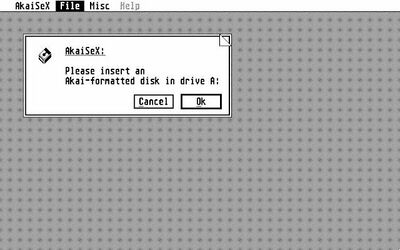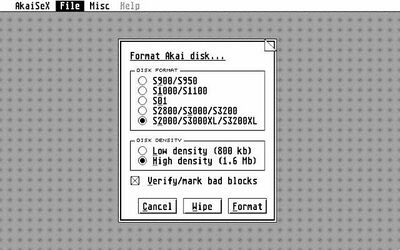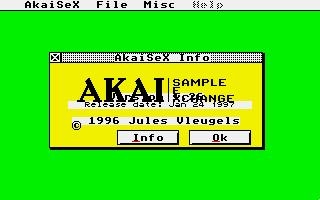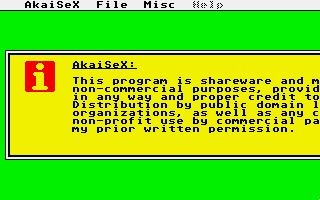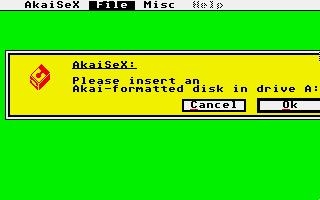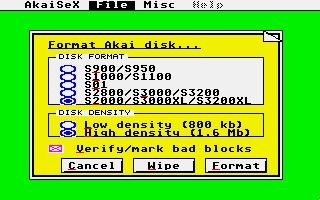AkaiSeX
Description: Reads any specific item (sample/program/effect settings/whatever) off Akai S900, S1000, S01, S3000, and S2000 disks and writes it back to any other of these disks, converting between the different formats and 12/16-bit sample format if necessary.
Version: 1.26
Resolutions: Low / Medium / High
Format: APP
Language: English
Link: File:akaisex-v1.26.zip
High Resolution
Medium Resolution
Low Resolution
AkaiSeX (Atari) version 1.23
Copyright © 1996 Jules Vleugels
Please read this entire file carefully; it contains some important information about the program. If nothing else, at least read through the paragraphs that are marked IMPORTANT!--they really contain vital bits of information.
This version of AkaiSeX runs on the Atari ST/STe/TT/Falcon range of computers. A PC/Windows port should either be available or become available soon, and both an Apple MacIntosh and a Commodore Amiga port are being worked at. See the `Ports' section for details.
Legal stuff
AkaiSeX is shareware and may be freely distributed for non-commercial purposes, provided the package is passed as a whole, the files are not modified in any way, and proper credit to the author is given. However, AkaiSeX is NOT freeware. Distribution by public domain libraries, magazines, or any other organizations, and any commercial use of this program, including non-profit use by commercial parties, is prohibited without my prior written permission.
Although the program has been tested extensively and appears to be free from serious bugs, I cannot and will not take responsibility for any damage resulting, directly or indirectly, from the use of this program. This program is distributed in the hope that it will be useful, but without any warranty; without even the implied warranty of merchantability or fitness for a particular purpose. The entire risk as to the quality and performance of the program is with you. Should the program prove defective, you assume the cost of all necessary servicing, repair or correction. In short: use this program at your own risk or just do without it.
Contents
This archive should contain the following files:
AKAISEX.APP
The program itself
AKAISEX.RSC
Its resource file
README.TXT
The accompanying documentation
AkaiSeX may only be distributed with all of the above files.
About the program
Basically, AkaiSeX reads, writes, and formats Akai sampler disks. However, rather than archiving entire disk images (as the PC program TeleDisk does) it can read any separate item (program/sample/effect settings/whatever) off an Akai disk, and store it in a sampler-independent format. This item can now be written back to a different disk, even if this disk was formatted by a different Akai sampler; the items are automatically converted to the correct format. For example, using AkaiSeX one can now read a program along with the samples used therein from an S2000 disk, and write this program with its samples back to an S900 disk; the conversions between the different formats are completely user-transparent. Only sampler-specific data--such as effect settings and operating systems upgrades--can only be exchanged between compatible samplers.
The programs and sampler-specific data are stored in a custom format, a specification of which I will send out at request. Samples however are stored as standard AIFF-C files, which can easily be converted into other formats, or imported by other programs. This facilitates, for example, the use of sample editors with an Akai sampler. AkaiSeX will also import arbitrary AIFF and AIFF-C files and write their contents to a sampler disk of choice.
Currently the following Akai samplers are supported:
S900/S950 Although somewhat surpassed by the newer generation of samplers, there are still a huge number of these beasts around, and they still enjoy immense popularity as an entry-level sampler. This is probably due to their relatively good--albeit it only 12 bit--sound and their very affordable price. The main difference between the S900 and the S950 is that the S950 has digital ADSR low-pass filters, an HD disk drive, and allows for more internal memory. Because the S900's operating system can be upgraded to encompass most of these features (see "Goodies" section) I will in the following refer only to the S950.
While working on this program I figured it would be good to make trading samples, including libraries of the newer samplers, possible for S950 users by supporting these samplers. Although not all features of the newer samplers are available on the S950, I've tried to closely map all parameters in order to allow as faithful a reproduction of programs and samples as possible.
S1000/S1100 These samplers mark Akai's switch to 16-bit sampling technology. AkaiSeX will transfer nearly all features of these samplers with some very minor exceptions, the most important of which may be that the S1000/S1100 allows for eight loops per sample whereas this number has been reduced to four with the newer samplers. Note that this is a limitation imposed by the newer samplers and not by the program: samples transferred between two S1000/S1100s by AkaiSeX will still contain all eight original loops. S01 The philosophy adopted with the S01 was to provide basic sampling facilities at an entry-level price. The S01 lacks most of the larger samplers' editing facilities and can hold at most eight samples in memory at once. Currently only sample import/export is provided for this sampler; I hope to add program support soon. (A program encompasses little more than setting a MIDI channel for each sample anyway.) S2800/CD3000/S3000/S3200 The S3000 series has been Akai's top-of-the-line for a couple of years. Almost every sample library is available in the S3000 series format, and many non-Akai samplers will import S3000 samples. All features of this series are supported by AkaiSeX; in fact, while developing this program I've tested it on my S2800. (And I can consequently only guarantee it to work with this sampler.) ;-) S2000/S3000XL/S3200XL The recently introduced S2000 series features a switch to better hardware upgradability, including multiple individual outputs and digital effects as options, as well as SIMM-upgradable internal memory. The architecture of these samplers however bears much similarity to that of the S3000 series, and all program and sample parameters are again supported.
Compatibility
This version of AkaiSeX runs on the Atari ST/STe/TT/Falcon range of computers. A PC/Windows port should either be available or become available soon, and both an Apple MacIntosh and a Commodore Amiga port are being worked at. See the `Ports' section for details.
The program has been tested on a MegaSTe/4 and a 1040ST, and runs without any problems on both. Due to the somewhat different architecture of the Falcon, I can not guarantee that it will do equally well on these boxes; the beta tests so far didn't bring up any problems.
AkaiSeX appears to be compatible with all system extensions I've come across so far. There's one minor bug: the ExtendedGEM library that AkaiSeX relies on leaves a memory leak of 232 bytes every time the program is run; quote it's beyond my control unquote. Other than that, there are no bugs--just a few unexpected features.
As for the disk format, AkaiSeX supports both double-density and high-density disks. Needless to say, the latter will only work if you have an HD disk drive installed.
IMPORTANT! To decide whether there is an HD disk drive installed, AkaiSeX will search the cookie jar (if there is one installed) for an _FDC cookie. If no such cookie is found, the program assumes that there is only a double-density disk drive available, and high-density disk access will be disabled. If you find that AkaiSeX works correctly with double-density disks but refuses to handle high-density ones, make sure that this cookie is present in the cookie jar. (A program that installs this cookie, called HD_FDC.PRG, is available from the usual FTP sites.)
IMPORTANT! Although AkaiSeX should work correctly with only a single disk drive, the number of times that disk need to be swapped is not really optimal--this may or may not be an understatement. I recommend using a RAM disk as the destination drive instead.
Usage
This version of AkaiSeX features a GEM interface. The menu items as they appear from left to right are explained below.
AkaiSeX / About
Displays the version number, release date, and copyright information about the program.
File / Get from disk...
Lists the contents of the Akai sampler disk in drive A: using a custom file selector. The first row lists the item names as they would appear in the sampler's directory, whereas the last row displays the corresponding file size (in bytes). The middle row is used to indicate the item type as follows:
b
- bulk
c
- cue list
f
- operating system
p
- program
s
- sample
x
- effect settings
The user can now select one or more of these items, and select `Get' to transfer these items to either the current directory or a fixed directory of choice (see Preferences below). If the line directly above the files reads `Programs+samples', the samples used in a program will automatically be loaded along with the program; `Selected items' will load only the actually selected items. The transfer can be aborted at any time by either clicking on `Abort' or pressing `Undo'. Additionally, clicking the `Delete' button will delete the selected items on the Akai disk. Use this with caution, as deleted items will be irrecoverably lost! File / Put to disk...
The reverse process of the previous menu item: the AkaiSeX files in either the current directory or the samples directory (see below) are listed, and the user is prompted to select the files to be transferred to the Akai sampler disk in drive A:. The icon at the top left corner, next to the "Close" button, rebuilds the index of the current directory (see "Misc/Rebuild Index" below). File / Preferences... The reverse process of the previous menu item: the AkaiSeX files in either the current directory or the samples directory (see below) are listed, and the user is prompted to select the files to be transferred to the Akai sampler disk in drive A:. IMPORTANT! If the disk contains an item with a name that is identical to the one being put, AkaiSeX will without any warning overwrite the existing item. I prefer this to having to click through hundreds of alert boxes, but let me know if you don't like this feature and maybe I'll change it in future versions.
File / Format disk... Using this menu item it is possible to format disks in an Akai-compatible format. The dialog box allows to choose the destination sampler and the disk density (low or high density). It is also possible to just wipe the contents of the disk without actually formatting it; for this to work, the disk should previously have been formatted in an Akai-compatible format.
IMPORTANT! I have only been able to test this with the S900 and the S3000 series samplers, so this function is still rather beta. Please let me know if your sampler won't accept disks that have been formatted by AkaiSeX.
Misc / Rebuild index Akai samplers allow item names of up to 12 characters, whereas many computer file systems have a limit of eight characters. To unambiguously map each item to a unique filename, AkaiSeX maintains a file `AKAISEX.DIR' containing an index of items and their corresponding filenames for each directory. This index is automatically updated with every transfer from/to a sampler disk, but might become inaccurate if the user moves files between directories from without the program. Because AkaiSeX can only correctly deal with files that are listed in the index, this menu item should be chosen if the program does not correctly list all files in the current directory. The program will then try to identify all files in the current directory, and add the appropriate ones to the index. IMPORTANT! AkaiSeX will only try to identify files with an ".A?X" filename extension; the second character, which indicates the type of data in the file, is meant only as a convenience to the user and is ignored in the above operation. AIFF(-C) files containing sample data should have an extension of either ".AIF" or ".AFC" to be recognized by the program.
Goodies
The following goodies are currently available as a direct spin-off of this program:
S900 operating system upgrade to v4.0
Apart from the differences in hardware between the S900 and the S950, the S950's operating system contains many features that do not exist on the S900. (The most striking of which is probably the digital ADSR low-pass filter that is available on the S950.) Although Akai did provide an operating system upgrade for the S900 that adds to the S900 almost all features found on the S950, this is not very well-known; in fact, Akai US at some point pointed out to me that they didn't even know this upgrade existed. An important factor in this may have been that the disk containing this upgrade cannot be copied directly, not even an S950 can do this--it just never appears in any directory listing.
AkaiSeX however treats the operating system upgrade as just another file on the S900's disk, so it can without any problems read and write it. The file S90040.AFX included in this package contains an image of the new operating system, whereas FIXUPS.AFX contains a boot loader that performs the actual loading of the new operating system into the S900's memory. To employ the new operating system, simply use AkaiSeX to transfer these two files to any S900 disk. Although the upgrade can reside together with programs and samples on one disk, I recommend that you do not write the upgrade to disks that contain important data. To load the upgrade into the S900 either insert the disk before power-up, or simply select `Clear memory and load entire disk' in the DISK menu.
And yes, I do have permission from Akai to distribute this operating system, so you're not doing anything illegal by using this upgrade.
Ports and supporting software
Although this version of AkaiSeX runs only on the Atari ST/STe/TT/Falcon computers, the following platforms either are or will soon be supported as well:
PC/Windows
Gert Voets <voets@oce.nl> is currently porting this program to the PC/Windows environment, adding a graphical front end along the way. A first pre-beta is finished; we hope to make it available soon.
Apple MacIntosh / Commodore Amiga
An attempt at porting AkaiSeX to the Mac and Amiga environments is currently in progress. However, it is still too early to make any definite statements about this. I will announce any new developments on the Akai web page. If you are interested in porting this program to any platform not listed here, please contact me for details (see the `Support' section below). In addition to this, the following applications either support or will soon support the various file formats used by AkaiSeX:
Zero-X sample editor A next release of Vinga System's sample editor Zero-X for the Atari range of computers will fully support import/export of AkaiSeX sample files, as well as direct import/export of samples from Akai sampler disks. Silicon Graphics audio library The file formats used by AkaiSeX will be supported by a next release of the SGI audio library. This facilitates the development of SGI applications that support Akai samplers.
Support (OBSOLETE SINCE 2001)
The latest version of this program, as well as information on the latest developments and ports to other platforms, can be obtained from my unofficial Akai website:
https://web.archive.org/web/19990203163913/http://www.cs.uu.nl/~jules/Akai/
Of course I welcome any suggestions that might help improve the quality of this program, or the support for a particular sampler. Also if you think you've found a bug I'll be glad to hear from you--there undoubtedly are some left. If you use this program regularly and have access to email, I encourage you to send me your email address so I can easily keep you informed on the latest developments. Also this will give me a good idea of how many people actually find this program useful.
Credits I am greatly indebted to everybody who has helped me, directly or indirectly, with the development of this program. In particular I want to mention Gert Voets for the soon-to-come PC/Windows port, Paul Kellett for his help with the Akai disk format, Peter Segerdahl for beta testing and providing test disks, Alex Buurman for helping me in every way possible, Christian Grunenberg for his ExtendedGEM library, and Peter Missel for his extensive Atari knowledge. The S900 operating system v4.0 is Copyright © 1988 Akai Ltd. Corporation.
Happy sampling!
-- Jules



